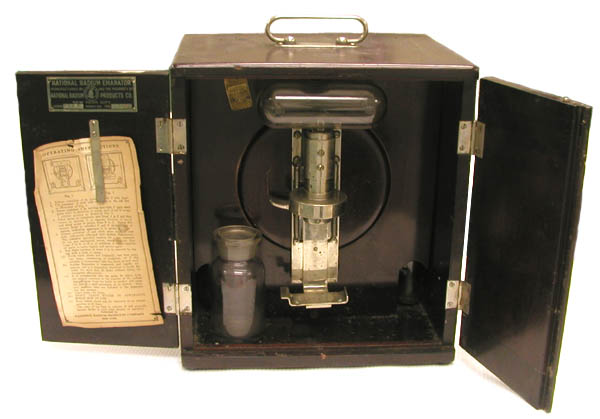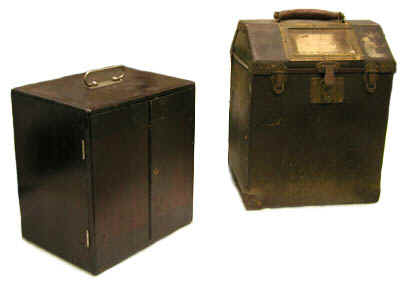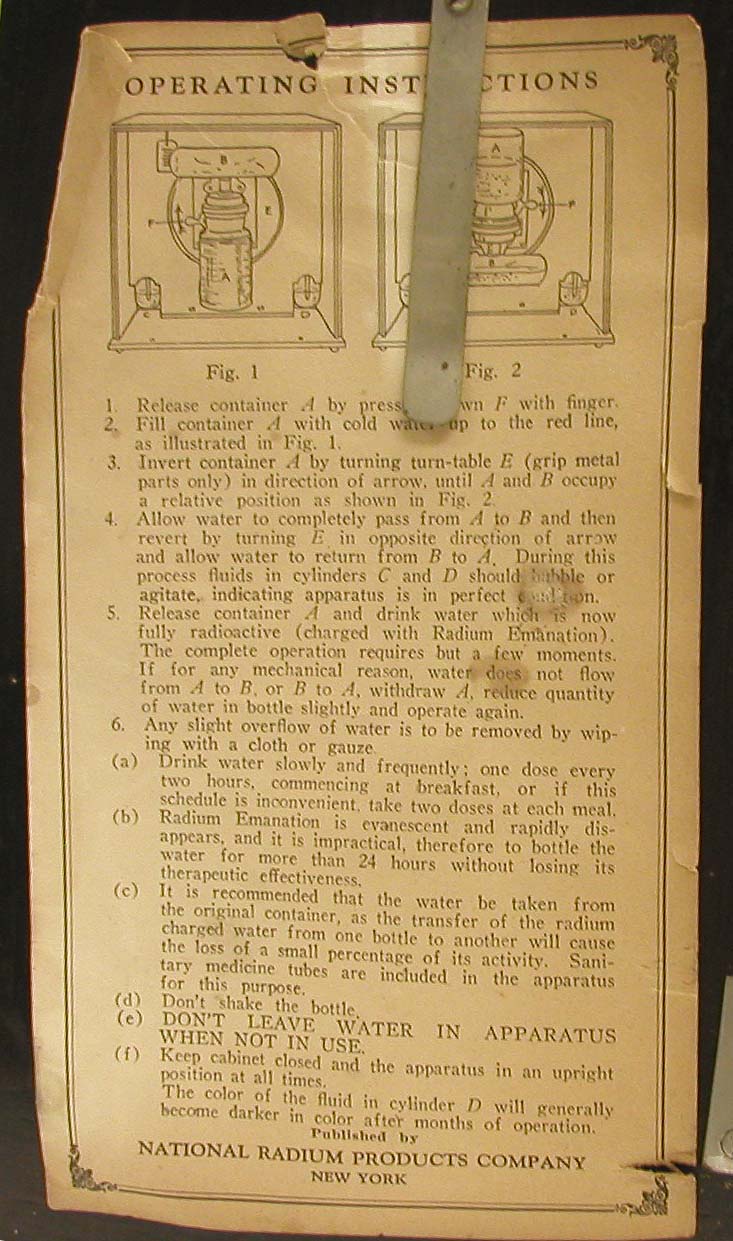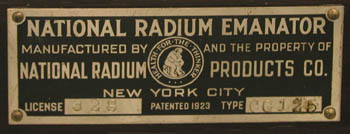The National Radium Emanator (ca. 1923-1930)

The National Radium Emanator, an extremely sophisticated device, was produced ca. 1924-1929 by National Radium Products Company of New York City.
The photo above shows the emanator alongside its carrying case. The photograph below is a close-up of the instructions that are clipped to the inside of the door of the unit.

Quoting the company literature:
The National Radium Emanator
“The Storage Battery of Radium Energy”
ACCEPTED by the American Medical Association, meeting their standard requirements as to dosage.
The National Radium Emanator will last a lifetime... it will maintain constantly its efficiency and radioactivity; none of the radium content being lost.”

The American Medical Association described it thusly:
“A portable appliance for activating water with emanation; the emanation is emitted from a solution of radium chloride, barium chloride and sodium chloride. The emanations pass through a purifying chamber into a compartment containing the water to be drunk.”
The glass bottle (lower left corner of the unit in the top photo) was filled with tap water and then mounted in the holder as shown in Figure 1 of the instructions. The holder was then rotated to an upside down position so that radon gas bubbled through the water thereby charging it. Next, the holder was returned to its original position so that the bottle, now filled with radioactive water, could be removed. Finally, the water was transferred to a drinking glass and consumed or used for some other purpose such as watering plants.
Based on the measured exposure rates around the emanator, we estimated that it contained a substantial fraction of a millicurie of Ra-226 (0.1-0.5 mCi ?).
In order to reduce the exposure rate to a level that would allow the unit to be put on display, we had to remove the source. The latter consisted of a dried deposit on the inside of a series of glass tubes and vessels in the back of the case.

Versions of the device were available with the following source strengths: 50,000, 100,000, 150,000, and 200,000 Mache Units. By way of explanation, the 50,000 MU device would impart about 18 microcuries of radon to one liter of water per day (New and Nonofficial Remedies. AMA. 1924)
Size: ca. 14" x 12" x 8"
Case: Wood (mahogany?)
Exposure rate: ca. 5-8 mR/hr above background at one foot prior to the removal of the source
Its Unique Capability
In the patent, Herbert Savoye explained what was unique about the device:
“I am aware that it has heretofore been the practice to prepare radioactive water by first passing a stream of `purified air through a solution of radium salt to take up radium emanations, and then to bubble the air... through the water to be treated where by the... emanations are absorbed by the water from said air, consequently my present invention is confined to providing a novel construction of apparatus for practicing such general method in such a manner that the air serving as the transferring vehicle or agent may be repeatedly circulated through both the radium salt solution and the water... so that a desired maximum degree of saturation of the given volume of water with soluble radium principles may be easily and quickly attained.”
American Radium Products Company
Before there was the National Radium Products Company, there was the American Radium Products Company. The latter, located in Morristown, NJ, was incorporated in 1922 with a listed capital of $100,000. Its purpose was to “manufacture medical supplies.” The notice of incorporation identified the following individuals: Francis H. Glazebrook, Ernest R. Rubsamen and Samuel C. Cutler (Drug and Chemical Markets Vol. 10, Jan. 18, 1922).
American Radium Appliance Company
Like the American Radium Products Company, the American Radium Appliance Company was incorporated in 1922, capitalized at $100,000 and located in Morristown, NJ. The same three folks were identified as being associated with the company (albeit in a different order): Ernest R. Rubsamen, Samuel C. Cutler, and Francis H. Glazebrook. Rather than manufacture medical supplies, the notice of incorporation indicated that the company would “manufacture radium specialties” (Chemical & Metallurgical Engineering. Vol. 26, No. 4, 1922).
If there was an intended difference between the American Radium Products Company and the American Radium Appliance Company, I don’t know what it was. Perhaps one was to focus on manufacturing and the other on sales. They didn’t seem to have lasted very long—the only references I have found to them date from 1922. My guess is that they ceased operations when the National Radium Products Company was incorporated (1923/1924).
Savoye’s patent for the radium emanator was assigned to the American Radium Appliance Company, but it would be the National Radium Products Company that would manufacture and sell the device.
National Radium Products Company
The earliest references I have found to the National Radium Products Company are from 1924. One was a notice that appeared in the Journal of Medical-physical Research (Vol. 2, 1924). It reported that the National Radium Products Company “will exhibit their new radium emanator models for office, home and hospital” at an upcoming medical conference. I suspect that the company was organized in 1923 in order to take over the operations of the American Radium Products Company and the American Radium Appliance Company.
There is evidence that the National Radium Products Company might have existed as late as 1933 (1933 New York City Directory). nevertheless, I suspect that its existence was in name only after 1929.
I have found several addresses for the company: 345 Madison Avenue, 18 West 45th Street (1927-1928) and 445 West 41st Street (1931-1933) in New York. Of course, there might have been others.
National Radium Products Company’s product line seems to have been limited to one item: the National Radium Emanator featured above.
Reflecting the fact that the company’s first president, Francis Glazebrook, was a physician, the company’s literature was aimed squarely at medical professionals, e.g.,
"An outline of radium and its emanations, a complete handbook for the medical profession" (A.E. Fein. 33 pages, 1924)"
“The effect of radium therapy upon physiology & metabolism” (M.J. Rosenau. 1924)
“Radium Therapy in Gout, Arthritis and Rheumatism” (16 pages. 1925)
“Radium Therapy in High Blood Pressure and Circulatory Diseases” (1925)
Herbert F. Savoye
The National Radium Emanator was invented by Herbert Savoye of Hackensack, New Jersey—he filed the patent for it on February 8, 1922(Apparatus for Preparing Artificial Radioactive Water, 1,452,709). The patent, which he assigned to the American Radium Appliance Company, was granted April 24, 1923. A nice birthday present, he turned 30 years old that month.
A little earlier, in 1919, Savoye filed a notice of organization for the Radio-Active Compounds Company “to manufacture chemicals, etc.” (Drug & Chemical Markets Vol. 5, Mar. 19, 1919). Whether or not the company manufactured anything is unknown, but I doubt that it did. The 1920 census indicated that Savoye was living with his parents and working as a salesman for a brokerage house. Ten years later he had the same job, but had moved out of his parent’s home and started a family. There is no indication that he was involved in the manufacture or marketing of the emanator.
Francis Henry Glazebrook
Francis H. Glazebrook was born in Maryland in 1877, but he spent most of his adult life living and working in Morristown, N.J. and New York City. He graduated from Cornell in 1900 with a medical degree. In 1902 he married Grace Squire, and together they had two children.
At various times, he managed a private medical practice, served as a coroner for Morris County, NJ. (ca. 1911), served as the secretary and treasurer of the Board of Health for the City of Morristown, was president of the Morris County Milk Commission (ca. 1915, 1916), was on the Executive Committee of the Medical Society of New Jersey (1922), and had a staff position at the Presbyterian Hospital in New York City (1921). He was also the Medical Director for the New York Stock Exchange (ca. 1929-1935). If he had known CPR, the Black Friday stock market crash of 1929 would have kept him busy dealing with heart attacks on the trading floor.
The bottom line is that he was a civic-minded physician rather than a businessman. This is attested to by the subject matter of his book, “Abundant Life: a Doctor Speaks of Health” (Christopher Publishing House, Boston. 1952).
By one means or another, Glazebrook became aware of Savoye’s emanator and took steps to get it into production. This involved the creation of two companies, the American Radium Products Company and the American Radium Appliance Company. Savoye’s patent was assigned to the latter. By 1924, both of these appear to have been dissolved and the production of the emanator taken over by the National Radium Products Company in New York City.
Glazebrook served as president of National Radium Products Company at the beginning, but very soon that position was taken over by A. Edwin Fein. At the end, as indicated by the 1933 New York City Directory, Fein still served as the president while Glazebrook functioned as the company's vice-president-treasurer. The company products were described in the Directory as "phys supplies mfrs." In other words, National Radium Products manufactured and distributed physician's supplies. It is not known if any of these employed radium.
National Radium Products Company was not a scam operation whose primary objective was to make money - at least from Glazebrook’s perspective. He actually seemed to have believed that medical benefits could be derived from drinking radioactive water, and that he had a responsibility to make these benefits available to the public. The following quotes are from a paper he published in 1922, (The Treatment of High Blood Pressure with Radioactive Water. American Medicine Vol 28. June, 1922).
“Mankind, thru disregard of the laws of nature and the abuse of his body functions, has been cut down before his accorded time on earth... the “fountain of youth” is in the reach of every living being... Radium is the one hope of the future... I believe that the future of radium will prove to be in its internal administration... no one questions the curative value of the waters of the world’s famous [health] springs, nor is there any question that this curative factor is due largely to radio-activity... The general profession has neglected therapy with radio-active water. On account of the impossibility to procure it, until very recently the only portable appliances for this purpose were cumbersome and crude”
“A simple, easily regulated and thoroly [sic] scientific appliance has been devised where-by soluble radium chloride dissolved in salt solution may be used.
"This appliance is portable and makes it possible for a patient to have an adequate supply of radio-active water constantly available. Since a considerable amount of radium is needed, it is the custom to rent these appliances under the direction of the medical attendant”
I suppose we might give Glazebrook a pass for the sales pitch at the end, but the spelling is a little harder to forgive.
For what it’s worth, this paper would frequently be quoted by other manufacturers of radioactive curative devices (e.g., the Zimmer Radon Generator).
A. Edwin Fein
At first, A. Edwin Fein served as the vice-president and secretary of the National Radium Products Company, but he soon assumed Glazebrook’s position as company president. One reference incorrectly indicates that he only held that position from 1924-1925 (Who’s Who in American Jewry. 1980), while another suggests that it was 1925-1935 (American Jews: their lives and achievements. American Jewish Library Foundation. 1947).
Fein was variously described as a “business executive,” “management executive,” “marketing-management-research-consultant” (Who’s Who in American Jewry. 1980). Without doubt, he was an impressive guy. Born in 1898, he became president of the National Radium Products Company while he was still a student at Columbia University and/or New York University. Prior to that, from 1919 to 1922, he had been a manager at William H, Knox & Co. While his career is too extensive to consider here, it is worth noting that he seems to have been the President and General Manager of Sparklets Corporation for a period of time. Some of these “sparklets” were used to produce radon-containing sparkling water. Learn about this product.
The National Radium Products Company of Grand Junction, Colorado
The National Radium Products Company of Grand Junction Colorado had no relation to the New York company of the same name. Among other things, they did not operate at the same time. The Colorado company was incorporated in 1916 “to mine and treat radium ore” (Fairplay Flume. Feb. 4, 1916) and by 1922 they were out of business (Mines Register. Vol. 15. 1922).
Although they were primarily a mining operation, they seem to have marketed at least one commercial product: Radium Fertilizer. The latter was said to have the effect of “Eternal Sunshine” (Brodsky, A. A handbook of Radiation Measurement and Protection. 1978).
The man behind the National Radium Products Company, and also its president, was George W. Kunkle. It was a turbulent presidency, Kunkle was sued by company stockholders who claimed that he had defrauded them in a transfer of company stock and property. In 1922, the case made it all the way to the Colorado Supreme Court. The latter ruled in Kunkle’s favor, but the lawsuit proved to be the end of the company (Telluride Daily Journal, March 11, 1922).
No need to feel sorry for him. Within a year Kunkle was occupying the president’s office of his latest creation, the Vanadium Corporation of Colorado - undoubtedly with the majority of the company’s shares in his pocket.
It should also be noted that Kunkle was granted a patent in 1918 for a radium applicator (1,288,048) and another in 1921 for a radium emanator (1,395,120). Unfortunately, I don’t know if there was any attempt made to manufacture and market either of these.
He was certainly an interesting guy. For example, he was “an authority on Saurology” according to the November 2, 1925 issue of the Lincoln Star. Kunkle was being interviewed by the paper about the discovery of a portion of a fossilized dinosaur egg. He claimed it was the “first of its kind to be found in America.”
He was a politician in addition to being a dinosaur expert, and in 1912 he was elected to the Colorado state legislature. He ran for office as a socialist, but this was early in his career. The attractions of capitalism would soon prove irresistible. The following quotes from a newspaper account (Plateau Voice, October 4, 1912) give a feel for what he was like on the stump “Mr. Kunkle is an odd character. The way he disfigures the king’s English is something fierce... and his oratory is of the most unconventional sort... Mr. Kunkle is a verbal cyclone.”
Kunkle might also have done time, but maybe not as much as he was supposed to. The following is taken from the March 30, 1899 issue of the Eagle County Blade: “The sheriff’s office received the news of a jail break at Glenwood Springs on Monday. The telegraphic description of the escaped prisoners is as follows: “George Kunkle, six feet one inch in height, weight about 180 pounds, black hair and eyes.”
Perhaps it was a different George Kunkle.
The National Radium Products Company of St. Louis, Missouri
Apparently there was another unrelated “National Radium Products Company” in St. Louis. A newspaper advertisement taken out by one of their distributors, William H. Wild, indicated that they sold “Radium Medical Preparations, Compresses and Healing Radium Waters” (Troy Call. Feb. 24, 1922). Unfortunately, that is all I know about them.
References
- American Medical Association. New and Nonofficial Remedies. 1924.
- Herbert Savoye. Apparatus for Preparing Artificial Radioactive Water. U.S. Patent 1,452,709. April 24, 1923.
